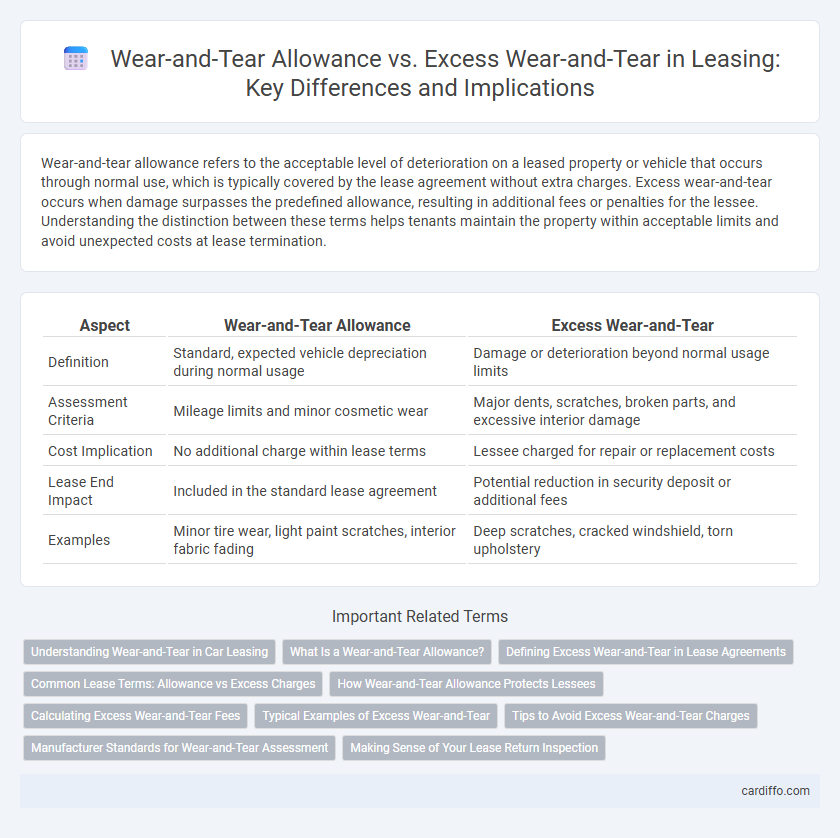Wear-and-tear allowance refers to the acceptable level of deterioration on a leased property or vehicle that occurs through normal use, which is typically covered by the lease agreement without extra charges. Excess wear-and-tear occurs when damage surpasses the predefined allowance, resulting in additional fees or penalties for the lessee. Understanding the distinction between these terms helps tenants maintain the property within acceptable limits and avoid unexpected costs at lease termination.
Table of Comparison
| Aspect | Wear-and-Tear Allowance | Excess Wear-and-Tear |
|---|---|---|
| Definition | Standard, expected vehicle depreciation during normal usage | Damage or deterioration beyond normal usage limits |
| Assessment Criteria | Mileage limits and minor cosmetic wear | Major dents, scratches, broken parts, and excessive interior damage |
| Cost Implication | No additional charge within lease terms | Lessee charged for repair or replacement costs |
| Lease End Impact | Included in the standard lease agreement | Potential reduction in security deposit or additional fees |
| Examples | Minor tire wear, light paint scratches, interior fabric fading | Deep scratches, cracked windshield, torn upholstery |
Understanding Wear-and-Tear in Car Leasing
Wear-and-tear allowance in car leasing refers to the predetermined limits on normal depreciation, including minor scratches and tire wear, accounted for in the lease agreement without additional charges. Excess wear-and-tear occurs when damage goes beyond these expected limits, such as deep dents, broken parts, or interior stains, which can result in extra fees at lease-end. Understanding these distinctions helps lessees manage maintenance responsibilities and avoid unexpected costs when returning the vehicle.
What Is a Wear-and-Tear Allowance?
A wear-and-tear allowance is a predetermined amount set aside by landlords or property managers to cover the normal deterioration of a leased property due to everyday use over time. It accounts for minor damages, fading, or aging that naturally occur without tenant negligence, protecting tenants from additional charges beyond reasonable use. This allowance differentiates between acceptable wear and excessive damage, ensuring fair maintenance responsibilities during and after the lease term.
Defining Excess Wear-and-Tear in Lease Agreements
Excess wear-and-tear in lease agreements refers to damage beyond normal use that exceeds the wear-and-tear allowance defined in the contract, often resulting in additional charges for the lessee. This includes issues like deep scratches, broken fixtures, or significant stains that go beyond standard aging or minor deterioration. Clear definitions in lease agreements help tenants understand their responsibilities and avoid unexpected fees related to property condition upon lease termination.
Common Lease Terms: Allowance vs Excess Charges
Wear-and-tear allowance in lease agreements defines the reasonable deterioration covered by the lessor without extra charges, typically based on factors like mileage limits and vehicle age. Excess wear-and-tear refers to damage beyond this allowance, triggering additional fees that tenants must pay at lease end. Understanding these common lease terms helps lessees anticipate potential costs and maintain the leased asset within acceptable condition standards.
How Wear-and-Tear Allowance Protects Lessees
Wear-and-tear allowance protects lessees by providing a predefined portion of the security deposit specifically for normal usage deterioration of the leased property, ensuring they are not charged unfairly for minor damages. This allowance sets clear expectations between lessors and lessees, minimizing disputes over the condition of the property at lease end. Consequently, it helps lessees avoid excess wear-and-tear charges, which otherwise could result in costly deductions beyond reasonable use.
Calculating Excess Wear-and-Tear Fees
Excess wear-and-tear fees are calculated by assessing damages that exceed the normal wear-and-tear allowance specified in the lease agreement. Landlords or property managers document and estimate repair costs for damages such as stains, holes, or broken fixtures beyond standard deterioration. Accurate calculations typically involve itemized invoices and depreciation schedules to determine tenant liability.
Typical Examples of Excess Wear-and-Tear
Typical examples of excess wear-and-tear in lease agreements include deep scratches or gouges in hardwood floors, large burns or stains on carpets, torn upholstery, broken windows, and holes in walls. These damages exceed normal wear-and-tear allowances and may result in additional charges to the lessee. Identifying such excess wear requires careful inspection and comparison to standard lease wear guidelines.
Tips to Avoid Excess Wear-and-Tear Charges
Regular maintenance and timely repairs significantly reduce the risk of excess wear-and-tear charges at lease-end. Documenting the vehicle's condition with photos and detailed notes upon delivery and return provides evidence to dispute unwarranted fees. Using seat covers, floor mats, and avoiding harsh driving conditions help preserve the leased property's condition and minimize costly excessive wear claims.
Manufacturer Standards for Wear-and-Tear Assessment
Manufacturer standards for wear-and-tear assessment provide specific criteria to differentiate allowable wear from excess wear in lease agreements. These standards often include detailed guidelines on what constitutes normal usage, ensuring that tenants are only responsible for damages beyond typical wear. Adhering to these manufacturer standards helps minimize disputes over wear-and-tear allowances and supports fair charges for excess wear.
Making Sense of Your Lease Return Inspection
Understanding the distinction between wear-and-tear allowance and excess wear-and-tear is crucial during a lease return inspection to avoid unexpected charges. Wear-and-tear allowance covers normal usage deterioration such as minor scratches or tire wear, while excess wear-and-tear refers to significant damages exceeding the lease agreement limits. Proper documentation and timely repairs can help mitigate costs associated with excess wear-and-tear charges at lease end.
Wear-and-Tear Allowance vs Excess Wear-and-Tear Infographic

 cardiffo.com
cardiffo.com